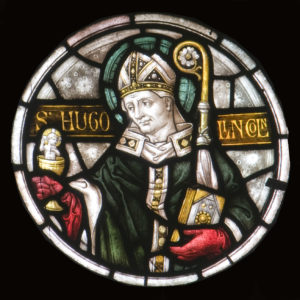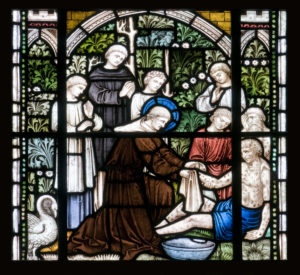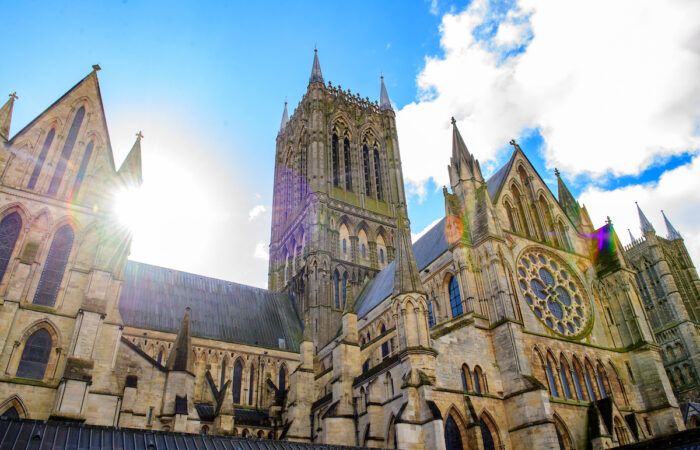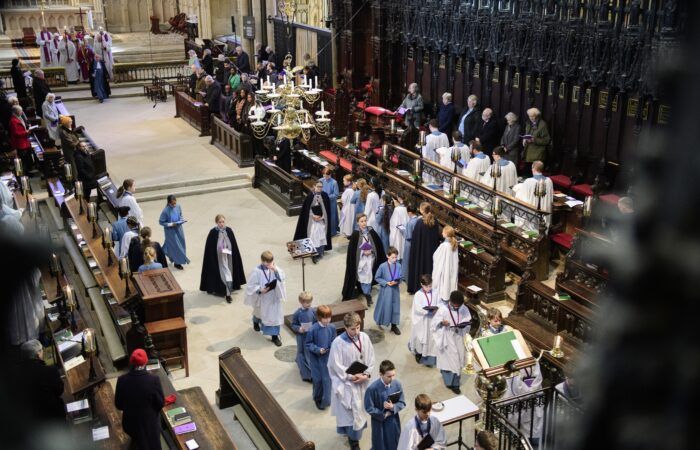Tuesday 17 November is the Feast of St Hugh of Lincoln, and 2020 is a special year as we mark 800 years since his canonisation. A special Eucharist will be streamed live on Facebook at 12noon and a new Journey’s of Faith pilgrimage book has been released to coincide with St Hugh’s Day.
Judi Jones, an historian and cathedral guide gives us an insight into the life of the monk Hugh of Avalon who would go on to rebuild Lincoln Cathedral
 St Hugh is Lincoln’s special saint and, although his magnificent golden shrine was destroyed on King Henry VIII’s orders, pilgrims still travel to the cathedral to venerate him. He was a remarkable man.
St Hugh is Lincoln’s special saint and, although his magnificent golden shrine was destroyed on King Henry VIII’s orders, pilgrims still travel to the cathedral to venerate him. He was a remarkable man.
Born in Avalon in France in 1135 into an aristocratic family, he entered the Augustinian Priory of Villard-Benoit when he was a child. His extraordinary intellect and piety was quickly recognised but Hugh wanted to live a more austere and enclosed life and therefore became a Carthusian monk at the Grande Chartreuse near Grenoble. The severity of the regime under which Hugh lived is underlined by the fact that even his innocent pastime of feeding the birds and animals was condemned by the prior because it brought him pleasure which could be construed as self-indulgent! Later, when he became Bishop of Lincoln he rejoiced in the company of his pet swan.
During his years at the Grande Chartreuse, Hugh’s extraordinary administrative skills were recognised, and came to the notice of King Henry II. The king asked that Hugh should become prior of his struggling new monastery in Witham in Somerset. Reluctantly Hugh agreed and he proved to be both a practical and inspirational leader, renowned for his humility and compassion.
In 1186 Hugh once again acceded to royal demands and was ordained Bishop of Lincoln. As he travelled to his new bishopric, accompanied by one lay brother and clutching a disreputable bundle of animal skins that he intended to use as bedding, Hugh was the antithesis of a grand worldly prelate. Now over fifty years old, and a Frenchman by birth (he probably spoke little English) with poor eyesight and plagued with digestive problems, he was expected to care for a huge diocese. Another challenge was the fact that a year earlier an earthquake had virtually destroyed the wonderful cathedral and left it in ruins.
 As Bishop of Lincoln, Hugh achieved miracles. Throughout his vast diocese he gained the love of ordinary people due to his care for the poor, for children and people suffering from leprosy and mental illness. He offered the Jewish community protection and ensured that atrocities happening elsewhere did not take place in his diocese. Hugh was able to attract talented administrators and scholars to Lincoln to ensure the smooth running of his unwieldy diocese. He bravely challenged King Henry II in protecting the privileges and powers of the church and improved the standards and lifestyle of the clergy.
As Bishop of Lincoln, Hugh achieved miracles. Throughout his vast diocese he gained the love of ordinary people due to his care for the poor, for children and people suffering from leprosy and mental illness. He offered the Jewish community protection and ensured that atrocities happening elsewhere did not take place in his diocese. Hugh was able to attract talented administrators and scholars to Lincoln to ensure the smooth running of his unwieldy diocese. He bravely challenged King Henry II in protecting the privileges and powers of the church and improved the standards and lifestyle of the clergy.
His most obvious legacy, however, is his work in rebuilding the cathedral. His holiness and charismatic personality ensured that people donated vast sums of money for this task. Hugh led from the front and reputedly worked as a labourer whenever it was possible. The result was the erection of a magnificent and awe-inspiring building. When he died in 1200 he was greatly mourned and his funeral was attended by two kings and many senior clerics. Soon after he was buried, reports of miracles began and, only twenty years later, he was proclaimed a saint.
Over the subsequent three centuries, St Hugh’s shrine was one of the great centres of pilgrimage in England, almost as important as that of St Thomas à Becket in Canterbury.

